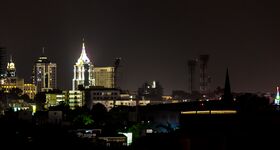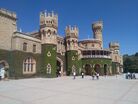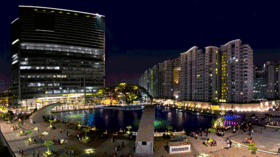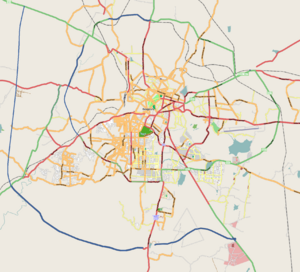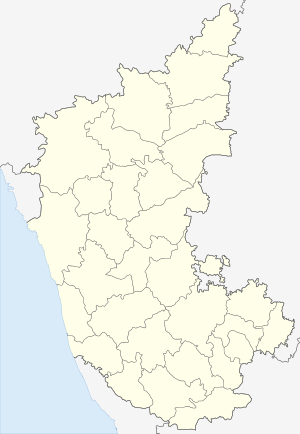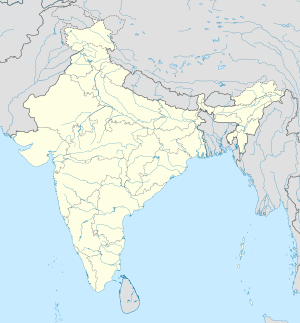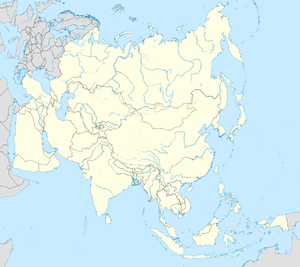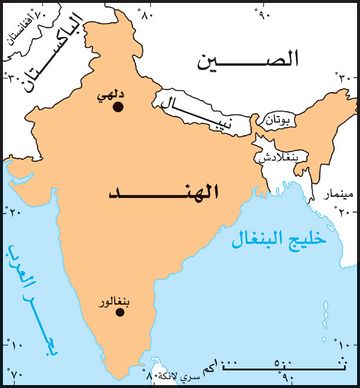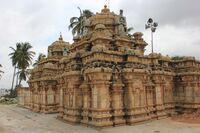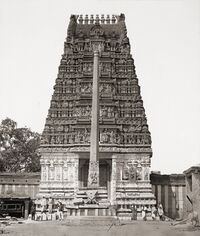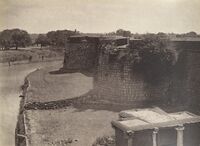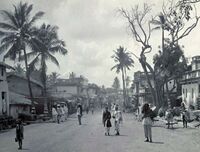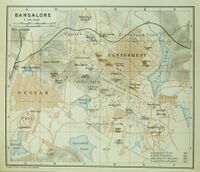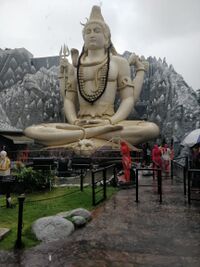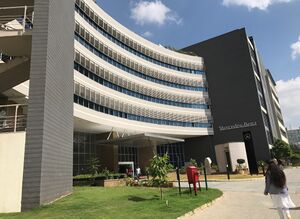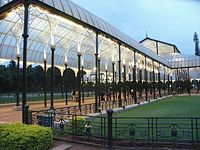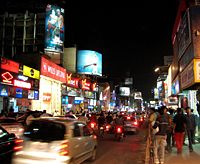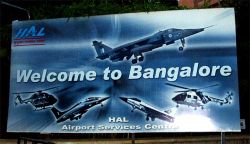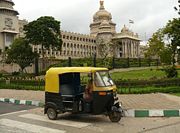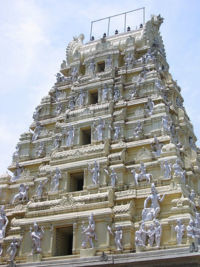بنگالور
بنگالور
Bangalore | |
|---|---|
From top, left to right: Bangalore Skyline, Vidhana Soudha, Bangalore Palace, Infosys, Bagmane Tech Park, ISKCON Temple at night, World Trade Center | |
| الكنية: | |
<mapframe> مشاكل:
Interactive map outlining Bangalore | |
| الإحداثيات: 12°58′44″N 77°35′30″E / 12.97889°N 77.59167°E | |
| Country | India |
| State | Karnataka |
| Region | Bayaluseemé |
| District | Bangalore Urban |
| Established | 1537 |
| أسسها | Kempe Gowda I |
| الحكومة | |
| • النوع | Municipal Corporation |
| • Administrator (In absence of Mayor) | Rakesh Singh, IAS |
| • Municipal Commissioner | Gaurav Gupta, IAS[3] |
| المساحة | |
| • Metropolis | 741 كم² (286 ميل²) |
| • العمران | 8٬005 كم² (3٬091 ميل²) |
| المنسوب | 920 m (3٬020 ft) |
| التعداد (2011)[7] | |
| • Metropolis | 8٬443٬675 |
| • الترتيب | 3rd |
| • الكثافة | 11٬000/km2 (30٬000/sq mi) |
| • Urban | 10٬456٬000 |
| • Rank | 5th |
| صفة المواطن | Bangalorean, Bengalurinavaru, Bengalurean, Bengaluriga |
| منطقة التوقيت | UTC+05:30 (IST) |
| Pincode(s) | 560 xxx |
| مفتاح الهاتف | +91-(0)80 |
| لوحة السيارة | KA-01, 02, 03, 04, 05, 41, 50, 51, 52, 53, 57, 58, 59, 60, 61 |
| Metro GDP | $110 billion[10] |
| Official language | Kannada[11] |
| الموقع الإلكتروني | www |
مدينة بنگالور هي عاصمة ولاية كارناتاكا، التي كانت تعرف بولاية ميسوره، يقدر عدد سكانها ب6,1 مليون نسمة تقع جنوب غرب ولاية كارناتاكا. وهي خامسة مدن الهند بعدد سكانها (3400000 نسمة لعام 1998) بعد مدن بومباي (مُمباي) ودلهي وكلكتة وتشناي (مَدراس).
ترجع نشأة بنغالور إلى القرن السادس عشر الميلادي، إذ كانت قرية قامت حول حصن ترابي، بناه زعيم محلي عام 1537م، وأعيد بناؤه بالحجارة عام 1761. وفي عام 1831 اتخذت الإدارة البريطانية الاستعمارية هذه النواة الأولى للمدينة مقراً لها ومركزاً إدارياً وعسكرياً حتى استقلال الهند عام 1947.
وتتألف بنغالور من نواة قديمة ذات مخطط منظم بشوارع عريضة وأبنية حديثة وحدائق. وتتبع المدينة معسكرات كبيرة للجيش في الأنحاء الشرقية منها، وفيها عدد من المعالم العمرانية، أبرزها مبنى الهيئة التشريعية وقصر مهراجا ميسور والمتحف الوطني، وفيها حديقة للنباتات مشهورة (لال باغ) وحديقة للحيوانات، وإلى الشمال منها منتجع صيفي بجواره معبدان للإله الهندوسي شيڤا. والمدينة آخذة بالتوسع على امتداد محاور الطرقات الرئيسية.
أصل الاسم
The name "Bangalore" represents an anglicised version of the city's Kannada name Bengalūru (النطق بالكندا: [ˈbeŋɡəɭuːru](![]() استمع)). It is the name of a village near Kodigehalli in Bangalore city today and was used by Kempegowda to christen the city as Bangalore at the time of its foundation. The earliest reference to the name "Bengalūru" was found in a ninth-century Western Ganga dynasty stone inscription on a vīra gallu (بالكنادا: ವೀರಗಲ್ಲು; حرفياً 'hero stone', a rock edict extolling the virtues of a warrior). In this inscription found in Begur, "Bengalūrū" is referred to as a place in which a battle was fought in 890 CE. It states that the place was part of the Ganga Kingdom until 1004 and was known as "Bengaval-uru", the "City of Guards" in Halegannada (Old Kannada).[12][13]
استمع)). It is the name of a village near Kodigehalli in Bangalore city today and was used by Kempegowda to christen the city as Bangalore at the time of its foundation. The earliest reference to the name "Bengalūru" was found in a ninth-century Western Ganga dynasty stone inscription on a vīra gallu (بالكنادا: ವೀರಗಲ್ಲು; حرفياً 'hero stone', a rock edict extolling the virtues of a warrior). In this inscription found in Begur, "Bengalūrū" is referred to as a place in which a battle was fought in 890 CE. It states that the place was part of the Ganga Kingdom until 1004 and was known as "Bengaval-uru", the "City of Guards" in Halegannada (Old Kannada).[12][13]
An apocryphal story recounts that the twelfth century Hoysala king Veera Ballala II, while on a hunting expedition, lost his way in the forest. Tired and hungry, he came across a poor old woman who served him boiled beans. The grateful king named the place "benda-kaal-uru" (literally, "town of boiled beans"), which eventually evolved into "Bengalūru".[12][14][15] Suryanath Kamath has put forward an explanation of a possible floral origin of the name, being derived from benga, the Kannada term for Pterocarpus marsupium (also known as the Indian Kino Tree), a species of dry and moist deciduous trees that grew abundantly in the region.[16]
On 11 December 2005, the Government of Karnataka announced that it had accepted a proposal by Jnanpith Award winner U. R. Ananthamurthy to rename Bangalore to Bengalūru.[17] On 27 September 2006, the Bruhat Bengaluru Mahanagara Palike (BBMP) passed a resolution to implement the proposed name change.[18] The government of Karnataka accepted the proposal, and it was decided to officially implement the name change from 1 November 2006.[19][20] The Union government approved this request, along with name changes for 11 other Karnataka cities, in October 2014, hence Bangalore was renamed to "Bengaluru" on 1 November 2014.[21][22]
التاريخ
التاريخ المبكر والوسيط
A discovery of Stone Age artefacts during the 2001 census of India at Jalahalli, Sidhapura and Jadigenahalli, all of which are located on Bangalore's outskirts today, suggest probable human settlement around 4000 BCE.[23] Around 1,000 BCE (Iron Age), burial grounds were established at Koramangala and Chikkajala on the outskirts of Bangalore. Coins of the Roman emperors Augustus, Tiberius, and Claudius found at Yeswanthpur and HAL indicate that the region was involved in trans-oceanic trade with the Romans and other civilisations in 27 BCE.[24]
The region of modern-day Bangalore was part of several successive South Indian kingdoms. Between the fourth and the tenth centuries, the Bangalore region was ruled by the Western Ganga dynasty of Karnataka, the first dynasty to set up effective control over the region.[25] According to Edgar Thurston[26] there were twenty-eight kings who ruled Gangavadi from the start of the Christian era until its conquest by the Cholas. These kings belonged to two distinct dynasties: the earlier line of the Solar race which had a succession of seven kings of the Ratti or Reddi tribe, and the later line of the Ganga race. The Western Gangas ruled the region initially as a sovereign power (350–550), and later as feudatories of the Chalukyas of Badami, followed by the Rashtrakutas until the tenth century.[16] The Begur Nageshwara Temple was commissioned around 860, during the reign of the Western Ganga King Ereganga Nitimarga I and extended by his successor Nitimarga II.[27][28] Around 1004, during the reign of Raja Raja Chola I, the Cholas defeated the Western Gangas under the command of the crown prince Rajendra Chola I, and captured Bangalore.[27][29] During this period, the Bangalore region witnessed the migration of many groups — warriors, administrators, traders, artisans, pastorals, cultivators, and religious personnel from Tamil Nadu and other Kannada-speaking regions.[25] The Chokkanathaswamy temple at Domlur, the Aigandapura complex near Hesaraghatta, Mukthi Natheshwara Temple at Binnamangala, Choleshwara Temple at Begur, Someshwara Temple at Madiwala, date from the Chola era.[27]
In 1117, the Hoysala king Vishnuvardhana defeated the Cholas in the Battle of Talakad in south Karnataka, and extended its rule over the region.[27] Vishnuvardhana expelled the Cholas from all parts of Mysore state.[30] By the end of the 13th century, Bangalore became a source of contention between two warring cousins, the Hoysala ruler Veera Ballala III of Halebidu and Ramanatha, who administered from the Hoysala held territory in Tamil Nadu.[27] Veera Ballala III had appointed a civic head at Hudi (now within Bangalore Municipal Corporation limits), thus promoting the village to the status of a town. After Veera Ballala III's death in 1343, the next empire to rule the region was the Vijayanagara Empire, which itself saw the rise of four dynasties, the Sangamas (1336–1485), the Saluvas (1485–1491), the Tuluvas (1491–1565), and the Aravidu (1565–1646).[31] During the reign of the Vijayanagara Empire, Achyuta Deva Raya of the Tuluva dynasty raised the Shivasamudra Dam across the Arkavati river at Hesaraghatta, whose reservoir is the present city's supply of regular piped water.[32]
التأسيس والتاريخ الحديث المبكر
Modern Bangalore was begun in 1537 by a vassal of the Vijayanagara Empire, Kempe Gowda I, who aligned with the Vijayanagara empire to campaign against Gangaraja (whom he defeated and expelled to Kanchi), and who built a mud-brick fort for the people at the site that would become the central part of modern Bangalore. Kempe Gowda was restricted by rules made by Achuta Deva Raya, who feared the potential power of Kempe Gowda and did not allow a formidable stone fort. Kempe Gowda referred to the new town as his "gandubhūmi" or "Land of Heroes".[15] Within the fort, the town was divided into smaller divisions—each called a "pete" (النطق بالكندا: [peːteː]). The town had two main streets—Chikkapeté Street, which ran east–west, and Doddapeté Street, which ran north–south. Their intersection formed the Doddapeté Square—the heart of Bangalore. Kempe Gowda I's successor, Kempe Gowda II, built four towers that marked Bangalore's boundary. During the Vijayanagara rule, many saints and poets referred to Bangalore as "Devarāyanagara" and "Kalyānapura" or "Kalyānapuri" ("Auspicious City").[34]
After the fall of the Vijayanagara Empire in 1565 in the Battle of Talikota, Bangalore's rule changed hands several times. Kempe Gowda declared independence, then in 1638, a large Adil Shahi Bijapur army led by Ranadulla Khan and accompanied by his second in command Shāhji Bhōnslé defeated Kempe Gowda III,[34] and Bangalore was given to Shāhji as a jagir (feudal estate). In 1687, the Mughal general Kasim Khan, under orders from Aurangzeb, defeated Ekoji I, son of Shāhji, and sold Bangalore to Chikkadevaraja Wodeyar (1673–1704), the then ruler of the Kingdom of Mysore for three lakh rupees.[35] After the death of Krishnaraja Wodeyar II in 1759, Hyder Ali, Commander-in-Chief of the Mysore Army, proclaimed himself the de facto ruler of the Kingdom of Mysore. Hyder Ali is credited with building the Delhi and Mysore gates at the northern and southern ends of the city in 1760.[36] The kingdom later passed to Hyder Ali's son Tipu Sultan. Hyder and Tipu contributed towards the beautification of the city by building Lal Bagh Botanical Gardens in 1760. Under them, Bangalore developed into a commercial and military centre of strategic importance.[34]
The Bangalore fort was captured by the British armies under Lord Cornwallis on 21 March 1791 during the Third Anglo-Mysore War and formed a centre for British resistance against Tipu Sultan.[37] Following Tipu's death in the Fourth Anglo-Mysore War (1799), the British returned administrative control of the Bangalore "pētē" to the Maharaja of Mysore and was incorporated into the Princely State of Mysore, which existed as a nominally sovereign entity of the British Raj. The old city ("pētē") developed in the dominions of the Maharaja of Mysore. The Residency of Mysore State was first established in Mysore City in 1799 and later shifted to Bangalore in 1804. It was abolished in 1843 only to be revived in 1881 at Bangalore and to be closed down permanently in 1947, with Indian independence.[38] The British found Bangalore to be a pleasant and appropriate place to station their garrison and therefore moved their cantonment to Bangalore from Seringapatam in 1809 near Ulsoor, about 6 km (4 mi) northeast of the city. A town grew up around the cantonment, by absorbing several villages in the area. The new centre had its own municipal and administrative apparatus, though technically it was a British enclave within the territory of the Wodeyar Kings of the Princely State of Mysore.[39] Two important developments which contributed to the rapid growth of the city, include the introduction of telegraph connections to all major Indian cities in 1853 and a rail connection to Madras, in 1864.[40]
التاريخ الحديث المتأخر والمعاصر
In the 19th century, Bangalore essentially became a twin city, with the "pētē", whose residents were predominantly Kannadigas and the cantonment created by the British.[41] Throughout the 19th century, the Cantonment gradually expanded and acquired a distinct cultural and political salience as it was governed directly by the British and was known as the Civil and Military Station of Bangalore. While it remained in the princely territory of Mysore, Cantonment had a large military presence and a cosmopolitan civilian population that came from outside the princely state of Mysore, including British and Anglo-Indians army officers.[بحاجة لمصدر]
Bangalore was hit by a plague epidemic in 1898 that claimed nearly 3,500 lives. The crisis caused by the outbreak catalysed the city's sanitation process. Telephone lines were laid to help co-ordinate anti-plague operations. Regulations for building new houses with proper sanitation facilities came into effect. A health officer was appointed and the city divided into four wards for better co-ordination. Victoria Hospital was inaugurated in 1900 by Lord Curzon, the then Governor-General of British India.[42] New extensions in Malleswaram and Basavanagudi were developed in the north and south of the pētē.[43] In 1903, motor vehicles came to be introduced in Bangalore.[44] In 1906, Bangalore became one of the first cities in India to have electricity from hydro power, powered by the hydroelectric plant situated in Shivanasamudra.[45] The Indian Institute of Science was established in 1909, which subsequently played a major role in developing the city as a science research hub.[46] In 1912, the Bangalore torpedo, an offensive explosive weapon widely used in World War I and World War II, was devised in Bangalore by British army officer Captain McClintock of the Madras Sappers and Miners.[47]
Bangalore's reputation as the "Garden City of India" began in 1927 with the silver jubilee celebrations of the rule of Krishnaraja Wodeyar IV. Several projects such as the construction of parks, public buildings and hospitals were instituted to improve the city.[2] Bangalore played an important role during the Indian independence movement. Mahatma Gandhi visited the city in 1927 and 1934 and addressed public meetings here.[24] In 1926, the labour unrest in Binny Mills due to demand by textile workers for payment of bonus resulted in lathi charging and police firing, resulting in the death of four workers, and several injuries.[48] In July 1928, there were notable communal disturbances in Bangalore, when a Ganesh idol was removed from a school compound in the Sultanpet area of Bangalore.[49] In 1940, the first flight between Bangalore and Bombay took off, which placed the city on India's urban map.[46]
After India's independence in August 1947, Bangalore remained in the newly carved Mysore State of which the Maharaja of Mysore was the Rajapramukh (appointed governor).[50] The "City Improvement Trust" was formed in 1945, and in 1949, the "City" and the "Cantonment" merged to form the Bangalore City Corporation. The government of Karnataka later constituted the Bangalore Development Authority in 1976 to co-ordinate the activities of these two bodies.[51] Public sector employment and education provided opportunities for Kannadigas from the rest of the state to migrate to the city. Bangalore experienced rapid growth in the decades 1941–51 and 1971–81, which saw the arrival of many immigrants from northern Karnataka. By 1961, Bangalore had become the sixth largest city in India, with a population of 1,207,000.[34] In the decades that followed, Bangalore's manufacturing base continued to expand with the establishment of private companies such as MICO (Motor Industries Company), which set up its manufacturing plant in the city.
By the 1980s, it was clear that urbanisation had spilled over the current boundaries, and in 1986, the Bangalore Metropolitan Region Development Authority, was established to co-ordinate the development of the entire region as a single unit.[51] On 8 February 1981, a major fire broke out at Venus Circus in Bangalore, where more than 92 lives were lost, the majority of them being children.[52] Bangalore experienced a growth in its real estate market in the 1980s and 1990s, spurred by capital investors from other parts of the country who converted Bangalore's large plots and colonial bungalows into multi-storied apartments.[53] In 1985, Texas Instruments became the first multinational corporation to set up base in Bangalore. Other information technology companies followed suit and by the end of the 20th century, Bangalore had established itself as the Silicon Valley of India.[34] Today, Bangalore is India's third most populous city. During the 21st century, Bangalore has suffered terrorist attacks in 2008, 2010, and 2013.
الجغرافيا
تقع في مركز المثلث الجنوبي من هضبة الدكن عند تقاطع خط العرض 12 درجة و58 دقيقة شمالاً مع خط الطول 77 درجة و35 دقيقة شرقاً، وقد أقيمت المدينة فوق أرض هضبية على ارتفاع 949م فوق سطح البحر، قريبة من حدود الولاية مع ولاية تاميل نادو.
وتجري في المقاطعة عدة أنهار تتجه إلى الجنوب الشرقي لترفد نهر كوفري Cauvery أو Kaveri الذي يؤلف المجرى الأعلى لنهر كوليدام الذي يصب في خليج البنغال مكوِّناً دلتا نهرية كبيرة.
المناخ
يتصف مناخ بنغالور بالاعتدال شتاءً، ومقبول صيفاً، ينتمي إلى النموذج السهبي شبه الجاف في المناخ الموسمي الهندي، يراوح معدل أمطارها السنوية بين 600 - 1000 مم.
Bangalore has a tropical savanna climate (Köppen climate classification Aw) with distinct wet and dry seasons. Due to its high elevation, Bangalore usually enjoys a more moderate climate throughout the year, although occasional heat waves can make summer somewhat uncomfortable.[54] The coolest month is January with an average low temperature of 15.1 °C (59.2 °F) and the hottest month is April with an average high temperature of 35 °C (95 °F).[55] The highest temperature ever recorded in Bangalore is 39.2 °C (103 °F) (recorded on 24 April 2016) as there was a strong El Niño in 2016.[56] There were also unofficial records of 41 °C (106 °F) on that day. The lowest ever recorded is 7.8 °C (46 °F) in January 1884.[57][58] Winter temperatures rarely drop below 14 °C (57 °F), and summer temperatures seldom exceed 36 °C (97 °F). Bangalore receives rainfall from both the northeast and the southwest monsoons and the wettest months are September, October and August, in that order.[55] The summer heat is moderated by fairly frequent thunderstorms, which occasionally cause power outages and local flooding. Most of the rainfall occurs during late afternoon/evening or night and rain before noon is infrequent. November 2015 (290.4 mm) was recorded as one of the wettest months in Bangalore with heavy rains causing severe flooding in some areas, and closure of a number of organisations for over a couple of days.[59] The heaviest rainfall recorded in a 24-hour period is 179 mm (7 in) recorded on 1 October 1997.[60]
| بيانات المناخ لـ Bangalore (1981–2010, extremes 1901–2012) | |||||||||||||
|---|---|---|---|---|---|---|---|---|---|---|---|---|---|
| الشهر | ينا | فب | مار | أبر | ماي | يون | يول | أغس | سبت | أكت | نوف | ديس | السنة |
| القصوى القياسية °س (°ف) | 32.8 (91.0) |
35.9 (96.6) |
37.3 (99.1) |
38.3 (100.9) |
38.9 (102.0) |
38.1 (100.6) |
33.3 (91.9) |
33.3 (91.9) |
33.3 (91.9) |
32.4 (90.3) |
31.7 (89.1) |
31.1 (88.0) |
38.9 (102.0) |
| متوسط القصوى اليومية °س (°ف) | 27.9 (82.2) |
30.7 (87.3) |
33.1 (91.6) |
34.0 (93.2) |
33.3 (91.9) |
29.6 (85.3) |
28.3 (82.9) |
27.8 (82.0) |
28.6 (83.5) |
28.2 (82.8) |
27.2 (81.0) |
26.5 (79.7) |
29.6 (85.3) |
| متوسط الدنيا اليومية °س (°ف) | 15.8 (60.4) |
17.5 (63.5) |
20.0 (68.0) |
22.0 (71.6) |
21.7 (71.1) |
20.4 (68.7) |
19.9 (67.8) |
19.8 (67.6) |
19.8 (67.6) |
19.6 (67.3) |
18.0 (64.4) |
16.2 (61.2) |
19.2 (66.6) |
| الصغرى القياسية °س (°ف) | 7.8 (46.0) |
9.4 (48.9) |
11.1 (52.0) |
14.4 (57.9) |
16.7 (62.1) |
16.7 (62.1) |
16.1 (61.0) |
14.4 (57.9) |
15.0 (59.0) |
13.2 (55.8) |
9.6 (49.3) |
8.9 (48.0) |
7.8 (46.0) |
| متوسط تساقط الأمطار mm (inches) | 1.9 (0.07) |
5.4 (0.21) |
18.5 (0.73) |
41.5 (1.63) |
107.4 (4.23) |
106.5 (4.19) |
112.9 (4.44) |
147.0 (5.79) |
212.8 (8.38) |
168.3 (6.63) |
48.9 (1.93) |
15.7 (0.62) |
986.9 (38.85) |
| Average rainy days | 0.2 | 0.4 | 1.1 | 3.1 | 6.7 | 6.2 | 7.2 | 9.9 | 9.8 | 8.3 | 3.8 | 1.4 | 58.1 |
| متوسط الرطوبة النسبية (%) (at 17:30 IST) | 41 | 32 | 29 | 35 | 47 | 62 | 65 | 67 | 64 | 65 | 61 | 53 | 52 |
| Mean monthly ساعات سطوع الشمس | 262.3 | 247.6 | 271.4 | 257.0 | 241.1 | 136.8 | 111.8 | 114.3 | 143.6 | 173.1 | 190.2 | 211.7 | 2٬360٫9 |
| Source 1: India Meteorological Department[61][62] | |||||||||||||
| Source 2: NOAA (sun: 1971–1990)[63] | |||||||||||||
الديمغرافيا
| النمو السكاني | |||
|---|---|---|---|
| Census | Pop. | %± | |
| 1941 | 406٬760 | ||
| 1951 | 778٬977 | 91.5% | |
| 1961 | 1٬207٬000 | 54.9% | |
| 1971 | 1٬654٬000 | 37.0% | |
| 1981 | 2٬922٬000 | 76.7% | |
| 1991 | 4٬130٬000 | 41.3% | |
| 2001 | 5٬101٬000 | 23.5% | |
| 2011 | 8٬425٬970 | 65.2% | |
| Source: Census of India[64][65] | |||
Bangalore is a megacity with a population of 8,443,675 in the city and 10,456,000 in the urban agglomeration,[8][7] up from 8.5 million at the 2011 census.[66] This makes it the third-most-populous city in India and the 18th-most-populous city in the world.[67] Bangalore was the fastest-growing Indian metropolis after New Delhi between 1991 and 2001, with a growth rate of 38% during the decade. Residents of Bangalore are referred to as "Bangaloreans" in English, Bengaloorinavaru or Bengaloorigaru in Kannada and Banglori in Hindi or Urdu.[68] People from other states have migrated to Bangalore, study, or work there as well.[69]
According to the 2011[تحديث] census of India, 78.9% of Bangalore's population is Hindu, a little less than the national average.[70] Muslims comprise 13.9% of the population, roughly the same as their national average. Christians and Jains account for 5.6% and 1.0% of the population, respectively, double that of their national averages. The city has a literacy rate of 89%.[71] Roughly 10% of Bangalore's population lives in slums.[72]—a relatively low proportion when compared to other cities in the developing world such as Mumbai (50%) and Nairobi (60%).[73] The 2008 National Crime Records Bureau statistics indicate that Bangalore accounts for 8.5% of the total crimes reported from 35 major cities in India which is an increase in the crime rate when compared to the number of crimes fifteen years ago.[74]
Bangalore suffers from the same major urbanisation problems seen in many fast-growing cities in developing countries: rapidly escalating social inequality, mass displacement and dispossession, proliferation of slum settlements, and epidemic public health crisis due to severe water shortage and sewage problems in poor and working-class neighbourhoods.[75]
اللغات
Official language of Bangalore is Kannada which is spoken by 44.5% of the population. The second-largest language is Tamil, spoken by 15.0% of the population. 14% speak Telugu, 12% Urdu, 6% Hindi, 3% Malayalam and 2.07% Marathi as their first language.[76][77] The Kannada language spoken in Bangalore is a form of Kannada called as 'Old Mysuru Kannada' which is also used in most of the southern part of Karnataka state. A vernacular dialect of this, known as Bangalore Kannada, is spoken among the youth in Bangalore and the adjoining Mysore regions.[78] English (as an Indian dialect) is extensively spoken and is the principal language of the professional and business class.[79]
The major communities of Bangalore who share a long history in the city other than the Kannadigas are the Telugus and Tamilians who migrated to Bangalore in search of a better livelihood, and Dakhanis.[80][81][82] Already in the 16th century, Bangalore had few speakers of Tamil and Telugu, who spoke Kannada to carry out low profile jobs. However the Telugu Speaking Morasu Vokkaligas are the native people of BangaloreThis statement isn't found in the book citation or anywhere else in the Web ![محل شك][83] Telugu-speaking people initially came to Bangalore on invitation by the Mysore royalty (a few of them have lineage dating back to Krishnadevaraya).[84]
Other native communities are the Tuluvas and the Konkanis of coastal Karnataka, the Kodavas of the Kodagu district of Karnataka. The migrant communities are Maharashtrians, Punjabis, Rajasthanis, Gujaratis, Tamilians, Telugus, Malayalis, Odias, Sindhis, Biharis, Jharkhandis and Bengalis.[80] Bangalore once had a large Anglo-Indian population, the second largest after Calcutta. Today, there are around 10,000 Anglo-Indians in Bangalore.[85] Bangalorean Christians are constituted by Tamil Christians, Mangaloreaon Catholics, Kannadiga Christians, Malayali Syrian Christians and Northeast Indian Christians.[86][87][88] Muslims form a very diverse population, consisting of Dakhini and Urdu-speaking Muslims, Kutchi Memons, Labbay and Mappilas.[89]
Other languages with large numbers of speakers include Konkani, Bengali, Marwari, Tulu, Odia, Gujarati, Kodagu, Punjabi, Lambadi, Sindhi and Nepali.[90] As in the rest of the state, Kannada is the most widely spoken language, but English is a commonly spoken second language in the city.
الإدارة المدنية
| Bangalore City officials | |
| العمدة | ممتاز بگوم |
| Municipal Commissioner | S Subramanya |
| Police Commissioner | N Achuta Rao |

الاقتصاد
Bangalore is second fastest growing metropolis in India.[91] Bangalore contribute 38% of India's total IT exports.[92] It's economy is primarily service oriented and industrialized. The economy of Bangalore is contributes by information technology, telecommunication, biotechnology, manufacturing and industries (electronics, machinery, electricals, automobiles, foods & beverages) sectors etc.[93] Major industrial areas around Bangalore are Adugodi, Bidadi, Bommanahalli, Bommasandra, Domlur, Hoodi, Whitefield, Doddaballapura, Hoskote, Bashettihalli, Yelahanka, Electronic City, Peenya, Krishnarajapuram, Bellandur, Narasapura, Rajajinagar, Mahadevapura etc.[94][95] Bangalore is one of the favorable business destinations. It is fifth city in India to host maximum numbers of Fortune Companies next to Mumbai, Delhi, Kolkata and Chennai.[96]
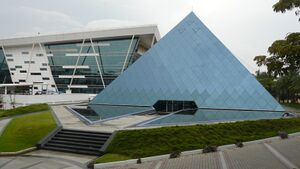
The growth of IT has presented the city with unique challenges.[97] Ideological clashes sometimes occur between the city's IT moguls, who demand an improvement in the city's infrastructure, and the state government, whose electoral base is primarily the people in rural Karnataka.[98] The encouragement of high-tech industry in Bangalore, for example, has not favoured local employment development, but has instead increased land values and forced out small enterprise.[99] The state has also resisted the massive investments required to reverse the rapid decline in city transport which has already begun to drive new and expanding businesses to other centres across India.[100] Bangalore is a hub for biotechnology related industry in India and in the year 2005, around 47% of the 265 biotechnology companies in India were located here; including Biocon, India's largest biotechnology company.[101][102] With an economic growth of 10.3%, Bangalore is the second fastest-growing major metropolis in India,[103] and is also the country's fourth largest fast-moving consumer goods (FMCG) market.[104] Forbes considers Bangalore one of "The Next Decade's Fastest-Growing Cities".[105] The city is the third largest hub for high-net-worth individuals and is home to over 10,000-dollar millionaires and about 60,000 super-rich people who have an investment surplus of ₹45 million (US$563٬551) and ₹5 million (US$62٬600) respectively.[106]
The city is widely regarded as Silicon Valley of Asia, since Bangalore has been the largest IT hub.[107] Infosys, Wipro, Mindtree, Mphasis, Flipkart, Myntra are headquartered in Bangalore.[108] A large number of information technology companies located in the city which contributed 33% of India's ₹1,442 billion (US$20 billion) IT exports in 2006–07.[109] Bangalore's IT industry is divided into three main clusters – Software Technology Parks of India (STPI); International Tech Park, Bangalore (ITPB); and Electronic City.[110] Most of the IT companies are located in Bommanahalli, Domlur, Whitefield, Electronic City, Krishnarajapuram, Bellandur, Mahadevapura.[111] The city turned out as IT hub due to the presence of many institutions like Bangalore University, Indian Institute of Science etc.[112] Bangalore is also known as Biotech Capital of India as it hosts as the headquarters of India's largest biotechnology company Biocon.[102] Startup companies such as Swiggy, Ola Cabs, InMobi, Quickr, RedBus are also based in the city.
Bangalore is a favorable destination for industrial developments. United Breweries Group is headquartered in Bangalore.[113] The city is an automobile hub.[114] Tata Hitachi Construction Machinery, Mahindra Electric, Bharat Earth Movers, Toyota Kirloskar Motor, Tesla India, Ather Energy are headquartered in Bangalore within there operations.[115] Robert Bosch GmbH, Mercedes-Benz, Volvo, General Motors, Royal Enfield, Honda Motorcycle and Scooter India, Scania AB, Larsen & Toubro have there plants and research & development (R&D) centers around Bangalore.[116] ABB, General Electric, Tyco International have there research & development centers in Bangalore.[117] Aerospace industries are also popular around Bangalore, which made it as Aviation Monopoly capital of India.[118] Airbus, Boeing, Tata Advanced Systems, Indian Space Research Organisation, Liebherr Aerospace have there units in Bangalore. Bangalore is also emerged as an electronics & hardware manufacturing hub of India. It houses Dell, Nokia, Philips, Wistron manufacturing and R&D units. Public sector undertakings (PSUs) such as Bharat Electronics Limited (BEL), Hindustan Aeronautics Limited (HAL), National Aerospace Laboratories (NAL), Bharat Earth Movers Limited (BEML), Central Manufacturing Technology Institute (CMTI), HMT (formerly Hindustan Machine Tools) and Rail Wheel Factory (RWF). SKF have a plant in Bangalore.[91]
بنغالور مدينة كبيرة متعددة الوظائف، فهي عقدة مواصلات برية ومركز تجاري مهم في جنوبي الهند، تخرج منها شبكة شعاعية كثيفة من الطرقات تنتشر في كل اتجاه. ويمر فيها أهم محور للمواصلات الهندية، وهو الطريق الوطني العريض الذي يربط فارناسي (بنارس) على نهر الغانج في الشمال، برأس نياكوماري في أقصى جنوبي الهند. وترتبط بنغالور بطرق جيدة في الشمال الغربي، وبتشناي على خليج البنغال، وبحيدر آباد في الشمال. كذلك تتقاطع فيها سكك حديد الجنوب الهندي، وبالقرب منها مطار هندوستان الداخلي الذي تنطلق منه رحلات إلى سري لانكة أيضاً. وتعد مدينة بنغالور مركزاً صناعياً مهماً في الهند، تشتهر بصناعة المنسوجات القطنية والصوفية والسجاد والتبغ والجلود والأحذية والصابون والبورسلان، والمنتجات الصيدلانية والإلكترونية والزجاج والورق والساعات والأدوات الزراعية، إضافة إلى صناعة الطائرات وتجهيزات السكك الحديدية والقطارات والمكنات والهواتف. ويجذب إليها النمو الصناعي والاقتصادي أعداداً متزايدة من المهاجرين مما جعلها تعاني نقص المياه المستهلكة في مجال الصناعة والاستعمالات المنزلية. وتأتي الوظيفة التجارية على أهميتها للجنوب الهندي في مركز متأخر عن الوظيفة الصناعية للمدينة، وهي تجارة داخلية بالدرجة الأولى، تنشط بينها وبين ظهيرها الجغرافي وباقي الولايات الهندية، مع تخصيص جزء من منتوجاتها الصناعية للتصدير. أما الوظيفة الثقافية والعلمية للمدينة فتتمثل بجامعتها التي بدأت فرعاً لجامعة ميسور عام 1916، ثم أصبحت جامعة مستقلة افتتحت عام 1946، وتضم عدة كليات أهمها الأقسام المختصة بالعلوم الزراعية لخدمة الزراعة المتطورة في الولاية. وفي المدينة معاهد مختلفة مثل معهد للأبحاث العلمية، ومعهد أبحاث الألبان ومخبر الأبحاث الوطنية للملاحة الجوية والطيران، وفرع لمعهد أبحاث الطاقة الوطنية إضافة إلى عدد من الكليات التعليمية المسائية ومكتبة عامة. وهي مركز لأبرز المؤسسات الطباعية في الهند لنشر الصحف اليومية والمجلات وغيرها، ومقر البث الإذاعي المحلي وقاعدة عسكرية مهمة في جنوبي شبه القارة الهندية.
الثقافة
التعليم
المواصلات
Bangalore's HAL Airport (IATA code: BLR) is India's third busiest[119] and functions as both a domestic and international airport and is well connected to several destinations in the world.
ديمغرافيا
سكان بنغالور من الهنود الذين يغلب عليهم الأصل الدرافيدي، وخاصة الفروع الدرافيدية الثلاثة: الكانادا، والتيلوغو، والتاميل الذين يتكلمون لهجات خاصة بهم تنتمي إلى أسرة اللغات الدرافيدية. وكان عدد السكان عام 1980 لايزيد على2.5 مليون نسمة، ارتفع إلى3.4 مليون نسمة عام 1998، نتيجة النمو الطبيعي للسكان والهجرة إلى المدينة.
المدن الشقيقة
 Minsk, Belarus (1973) [120]
Minsk, Belarus (1973) [120] Cleveland, Ohio, United States (1992)
Cleveland, Ohio, United States (1992) San Francisco, California, United States (2008)
San Francisco, California, United States (2008) Chengdu, Sichuan, China (2013)[121]
Chengdu, Sichuan, China (2013)[121]
انظر أيضاً
- List of people from Bangalore
- List of neighbourhoods in Bangalore
- List of tallest buildings in Bangalore
- List of tourist attractions in Bangalore
- List of Chola temples in Bangalore
- Taluks of Bangalore
- Tourism in Karnataka
المصادر
- هوامش
- ^ خطأ استشهاد: وسم
<ref>غير صحيح؛ لا نص تم توفيره للمراجع المسماةcnn-Dec2012 - ^ أ ب Basavaraja, Kadati Reddera (1984). History and Culture of Karnataka: Early Times to Unification. Chalukya Publications. p. 332. Archived from the original on 27 ديسمبر 2017. Retrieved 27 ديسمبر 2017.
- ^ "Gaurav Gupta is new BBMP Commissioner". The Hindu. 31 March 2021.
- ^ "History of BBMP". Bruhat Bengaluru Mahanagara Palike (BBMP). Retrieved 20 May 2021.
- ^ "Introduction - BMRDA". Bangalore Metropolitan Region Development Authority. Retrieved 20 May 2021.
- ^ H.S. Sudhira; T.V. Ramachandra; M.H. Bala Subrahmanya (2007). "City Profile — Bangalore" (PDF). Cities. Bangalore. 24 (5): 382. doi:10.1016/j.cities.2007.04.003. Archived from the original (PDF) on 24 ديسمبر 2012. Retrieved 13 أكتوبر 2013.
- ^ أ ب Bangalore Metropolitan/City Population section of "Bangalore Population Sex Ratio in Bangalore Literacy rate Bangalore". 2011 Census of India. Archived from the original on 26 January 2017.
- ^ أ ب "The World's Cities in 2016" (PDF). United Nations. October 2016. p. 4. Archived (PDF) from the original on 12 January 2017. Retrieved 4 March 2017.
- ^ "INDIA STATS : Million plus cities in India as per Census 2011". Press Information Bureau, Mumbai. National Informatics Centre. Archived from the original on 30 يونيو 2015. Retrieved 20 أغسطس 2015.
- ^ خطأ استشهاد: وسم
<ref>غير صحيح؛ لا نص تم توفيره للمراجع المسماةgdp - ^ "50th Report of the Commissioner for Linguistic Minorities in India (July 2012 to June 2013)" (PDF). Archived from the original (PDF) on 8 July 2016. Retrieved 14 January 2015.
- ^ أ ب Chandramouli, K (25 يوليو 2002). "The city of boiled beans". The Hindu. Chennai, India. Archived from the original on 5 مايو 2012. Retrieved 10 يونيو 2012.
- ^ "Inscription reveals Bengaluru is over 1,000 years old". The Hindu. Chennai, India. 20 أغسطس 2004. Archived from the original on 13 فبراير 2012. Retrieved 10 يونيو 2012.
- ^ Vijesh Kamath (30 أكتوبر 2006). "Many miles to go from Bangalore to Bengalūru". Deccan Herald. Archived from the original on 16 سبتمبر 2012. Retrieved 10 يونيو 2012.
- ^ أ ب Misra, Hemant; Jayaraman, Pavitra (22 May 2010). "Bangalore bhath: first city edifices". Mint. Retrieved 11 June 2012.
- ^ أ ب Aditi 2008, p. 6
- ^ "Bangalore to be renamed Bengaluru". The Times of India. 11 ديسمبر 2005. Archived from the original on 29 سبتمبر 2012. Retrieved 19 أبريل 2009.
- ^ "It will be 'Bengaluru', resolves BMP". The Hindu. Chennai, India. 28 سبتمبر 2006. Archived from the original on 1 أكتوبر 2007. Retrieved 16 مايو 2007.
- ^ "It'll be 'Bengaluru' from November 1". Deccan Herald. 8 أكتوبر 2006. Archived from the original on 6 أبريل 2012. Retrieved 10 يونيو 2012.
- ^ "From today, Bangalore becomes Bengalooru". The Times of India. 1 نوفمبر 2006. Archived from the original on 24 أكتوبر 2012. Retrieved 19 أبريل 2009.
- ^ Renaming, Cities (18 أكتوبر 2014). "Bangalore, Mysore, Other Karnataka Cities to be Renamed on 1 November". No. ibtimes.co.in. ibtimes.co.in. Archived from the original on 25 أكتوبر 2015. Retrieved 18 أكتوبر 2014.
- ^ Renaming, Cities (18 أكتوبر 2014). "Centre nod for Karnataka's proposal on renaming cities". The Hindu. Archived from the original on 18 أكتوبر 2014. Retrieved 18 أكتوبر 2014.
- ^ "Bangalore dates from 4,000 BC". The Times of India. 11 أكتوبر 2001. Archived from the original on 21 سبتمبر 2013. Retrieved 7 سبتمبر 2013.
- ^ أ ب Ranganna, T.S. (27 أكتوبر 2001). "Bangalore had human habitation in 4000 B.C." The Hindu. Archived from the original on 21 سبتمبر 2013. Retrieved 7 سبتمبر 2013.
- ^ أ ب Srinivas 2004, p. 69
- ^ Edgar Thurston and K. Rangachari (1909). Castes and Tribes of Southern India. Government Press, Madras.
- ^ أ ب ت ث ج Aditi 2008, p. 7
- ^ Sarma 1992, p. 78
- ^ Mysore: A Gazetteer Compiled for Government by B. L. Rice p.224
- ^ "The Digital South Asia Library-Imperial gazetteer of India". uchicago.edu. 1908–1931. Archived from the original on 16 ديسمبر 2008. Retrieved 16 فبراير 2006.
- ^ Aditi 2008, p. 8
- ^ Aditi 2008, p. 9
- ^ Pinto & Srivastava 2008, p. 8
- ^ أ ب ت ث ج Vagale, Uday Kumar (2004). "5: Bangalore: mud fort to sprawling metropolis". Bangalore—future trends in public open space usage. Case study: Mahatma Gandhi Road, Bangalore (Thesis). Virginia Polytechnic Institute and State University. p. 34–35. hdl:10919/9941. Archived (PDF) from the original on 5 يونيو 2012. Retrieved 26 سبتمبر 2020.
- ^ خطأ استشهاد: وسم
<ref>غير صحيح؛ لا نص تم توفيره للمراجع المسماةekoji - ^ Pinto & Srivastava 2008, p. 6
- ^ Sandes, Lt Col E.W.C. (1933). The military engineer in India, vol I. Chatham: The Institution of Royal Engineers. pp. 163–165. ISBN 978-1-84734-071-9.
- ^ "Raj Bhavan, Karnataka". The Homepage of Raj Bhavan, Government of Karnataka. Archived from the original on 6 February 2012. Retrieved 24 August 2012.
- ^ Srinivas 2004, p. 3
- ^ Ghosh, Jyotirmoy (2012). Entrepreneurship in tourism and allied activities: a study of Bangalore city in the post liberalization period (PDF). Pondicherry University. p. 86. Archived (PDF) from the original on 21 سبتمبر 2013. Retrieved 8 سبتمبر 2013.
- ^ Vagale, Uday Kumar (2004). "8: Public domain—contested spaces and lack of imageability". Bangalore—future trends in public open space usage. Case study: Mahatma Gandhi Road, Bangalore (Thesis). Virginia Polytechnic Institute and State University. p. 49. hdl:10919/9941. Archived (PDF) from the original on 5 يونيو 2012. Retrieved 26 سبتمبر 2020.
- ^ "1898 plague revisited". The Times of India. 17 نوفمبر 2012. Archived from the original on 21 سبتمبر 2013. Retrieved 8 سبتمبر 2013.
- ^ Jaypal, Maya (26 مارس 2012). "Malleswaram, Basavanagudi, the new extensions". Deccan Herald. Archived from the original on 8 سبتمبر 2013. Retrieved 8 سبتمبر 2013.
- ^ Karnataka State Gazetteer: Bangalore District, p. 91
- ^ Srinivasaraju, Sugata (10 أبريل 2006). "ElectriCity". Outlook India. Archived from the original on 21 يناير 2011. Retrieved 15 نوفمبر 2011.
- ^ أ ب Pinto & Srivastava 2008, p. 10
- ^ Mudur, Nirad; Hemanth CS (7 يونيو 2013). "Bangalore torpedo gave them their D-Day, 69 years ago". Daily News and Analysis. Archived from the original on 4 أكتوبر 2013. Retrieved 1 أكتوبر 2013.
- ^ Nair 2005, p. 70
- ^ S., Chandrasekhar (1985). Dimensions of Socio-Political Change in Mysore, 1918–40. APH Publishing. p. 135. ISBN 978-0-8364-1471-4.
- ^ Boland-Crewe, Tara; Lea, David (2004). The Territories and States of India. Psychology Press. p. 135. ISBN 978-0-203-40290-0.
When the new, extended Mysore was created on 1 November 1956 (by the addition of coastal, central and northern territories), Wodeyar became Governor of the whole state, which was renamed Karnataka in 1973.
- ^ أ ب Srinivas 2004, p. 4
- ^ "Death Toll Raised to 66 in Fire at Circus in India". The New York Times. 9 فبراير 1981. Archived from the original on 18 نوفمبر 2016. Retrieved 31 يناير 2017.
- ^ Benjamin, Solomon (أبريل 2000). "Governance, economic settings and poverty in Bangalore" (PDF). Environment & Urbanization. 12 (1): 35–36. doi:10.1177/095624780001200104. S2CID 14335580. Archived (PDF) from the original on 17 يوليو 2012. Retrieved 11 يونيو 2012.
- ^ "Rise in temperature 'unusual' for Bangalore". The Hindu. Chennai, India. 18 مايو 2005. Archived from the original on 8 فبراير 2012. Retrieved 2 يوليو 2007.
- ^ أ ب "Bangalore". India Meteorological Department, Government of India. Archived from the original on 8 July 2007. Retrieved 7 February 2007.
- ^ Bureau, Bengaluru (24 April 2016). "Bengaluru records highest temperature since 1931". The Hindu. Retrieved 5 September 2017.
- ^ Amaresh, Vidyashree (10 May 2006). "Set up rain gauges in areas prone to flooding". The Hindu. Chennai, India. Archived from the original on 16 December 2007. Retrieved 22 December 2007.
- ^ Ashwini Y.S. (17 December 2006). "Bangalore weather back again". Deccan Herald. Archived from the original on 4 December 2007. Retrieved 22 December 2007.
- ^ Bangalore. "Global monitoring precipitation". cpc.ncep.noaa.gov. Archived from the original on 3 March 2016. Retrieved 17 May 2016.
- ^ Sharma, Ravi (5 November 2005). "Bangalore's woes". The Frontline. Archived from the original on 20 February 2008. Retrieved 5 February 2008.
- ^ "Station: Bangalore/Bangaluru Climatological Table 1981–2010" (PDF). Climatological Normals 1981–2010. India Meteorological Department. January 2015. pp. 81–82. Archived from the original (PDF) on 5 February 2020. Retrieved 10 April 2020.
- ^ "Extremes of Temperature & Rainfall for Indian Stations (Up to 2012)" (PDF). India Meteorological Department. December 2016. p. M88. Archived from the original (PDF) on 5 February 2020. Retrieved 10 April 2020.
- ^ "Bangalore Climate Normals 1971–1990". National Oceanic and Atmospheric Administration. Retrieved 24 December 2012.
- ^ "Census population" (PDF). Census of India. p. 21. Archived (PDF) from the original on 19 مايو 2012. Retrieved 7 يونيو 2008.
- ^ "Provisional population totals, Census of India 2011" (PDF). Archived (PDF) from the original on 7 مايو 2012. Retrieved 29 نوفمبر 2011.
- ^ "Urban Agglomerations/Cities having population 1 lakh and above" (PDF). Censusindia. The Registrar General & Census Commissioner, India. Archived (PDF) from the original on 13 نوفمبر 2011. Retrieved 17 أكتوبر 2011.
- ^ "Cities having population 1 lakh and above" (PDF). censusindia.gov.in. Archived (PDF) from the original on 7 مايو 2012. Retrieved 24 يوليو 2012.
- ^ "Banglori Dakhni: How a language associated with Hyderabad thrives in Bengaluru too". The News Minute (in الإنجليزية). 2019-09-13. Retrieved 2021-07-25.
- ^ "Kannadigas assured of all support". The Hindu. Chennai, India. 23 يوليو 2004. Archived from the original on 30 يونيو 2011. Retrieved 10 مايو 2010.
- ^ أ ب "Population By Religious Community – Karnataka" (XLS). Office of The Registrar General and Census Commissioner, Ministry of Home Affairs, Government of India. 2011. Archived from the original on 13 September 2015. Retrieved 13 September 2015..Click on arrow adjacent to state Karnataka so that a Microsoft excel document is downloaded with district wise population of different religious groups. Scroll down to BBMP (M. Corp. + OG) in the document at row no. 596.
- ^ "Provisional Population Totals, Census of India 2011" (PDF). Government of India. Archived (PDF) from the original on 13 November 2011. Retrieved 28 December 2011.
- ^ "Total Population, Slum Population ..." Archived from the original on 6 August 2007. Census of India, 2001. 2006. Government of India
- ^ Warah, Rasna. "Slums Are the Heartbeat of Cities" Archived 17 فبراير 2006 at the Wayback Machine. The EastAfrican. 2006. National Media Group Ltd. 6 October 2003
- ^ "Snaphhots – 2008" (PDF). National Crime Records Bureau. Archived from the original (PDF) on 22 June 2011. Retrieved 21 October 2010.
- ^ Roy, Ananya; Ong, Aihwa (2011). "Speculating on the Next World City". Worlding Cities: Asian Experiments and the Art of Being Global. Vol. 42 (illustrated ed.). John Wiley & Sons. ISBN 978-1-4443-4678-7.
- ^ "C-16 Population By Mother Tongue - Town Level". censusindia.gov.in. Retrieved 2021-07-27. See BBMP (M Corp. +OG) (Part)
- ^ Kaminsky, Arnold P.; Long, Roger D. (2011). India Today: An Encyclopedia of Life in the Republic: An Encyclopedia of Life in the Republic. Vol. 1 (reprint ed.). ABC-CLIO. p. 75. ISBN 978-0-313-37463-0.
- ^ Brown, Keith; Ogilvie, Sarah (2010). Concise Encyclopedia of Languages of the World (revised ed.). Elsevier. p. 577. ISBN 978-0-08-087775-4.
- ^ Lindsay, Jennifer (2006). Between Tongues: Translation And/of/in Performance in Asia (illustrated, reprint, annotated ed.). NUS Press. p. 52. ISBN 9789971693398.
- ^ أ ب Prashanth, G N. "A melting pot that welcomes all". The Times of India. Archived from the original on 2 May 2014. Retrieved 9 September 2013.
- ^ Sarma, Deepika (4 أكتوبر 2012). "Building blocks of one of the city's largest communities". The Hindu. Archived from the original on 21 سبتمبر 2013. Retrieved 9 سبتمبر 2013.
- ^ Srinivas 2004, The Settlement of Tamil-Speaking Groups in Bangalore
- ^ Srinivas 2004, p. 5
- ^ Srivatsa, Sharath S. (31 أكتوبر 2007). "Bangalore calling: it all goes way back..." The Hindu. Archived from the original on 21 سبتمبر 2013. Retrieved 9 سبتمبر 2013.
- ^ M. V. Chandrasekhar; Sahana Charan (23 ديسمبر 2006). "They are now part of city's unique social mix". The Hindu. Archived from the original on 21 سبتمبر 2013. Retrieved 9 سبتمبر 2013.
- ^ Crossette, Barbara; Times, Special To the New York (20 January 1990). "Bangalore Journal; Christians Revel in Conversion Back to Indianness". The New York Times.
- ^ Hefner, Robert W. (2013). Global Pentecostalism in the 21st Century (in الإنجليزية). Indiana University Press. pp. 194–222. ISBN 978-0-253-01094-0.
- ^ Christopher, Joseph (31 مارس 2014). "In the Indian rector's murder, the 'why' matters as much as the 'who'". UCA News. Archived from the original on 9 أبريل 2014. Retrieved 1 مايو 2014.
- ^ Gayer, Laurent; Jaffrelot, Christophe (2012). Muslims in Indian Cities: Trajectories of Marginalisation (illustrated ed.). Hurst Publishers. p. 290. ISBN 978-1-84904-176-8.
- ^ 2011 census
- ^ أ ب Briefing, India (2019-03-22). "Bengaluru: Economy, Industries, and Infrastructure". India Briefing News (in الإنجليزية). Retrieved 2021-08-24.
- ^ "'Bangalore will become the world's largest IT cluster by 2020'". @businessline (in الإنجليزية). Retrieved 2021-08-16.
- ^ Briefing, India (2019-03-22). "Bengaluru: Economy, Industries, and Infrastructure". India Briefing News (in الإنجليزية). Retrieved 2021-08-16.
- ^ "BRIEF INDUSTRIAL PROFILE OF BANGALORE RURAL DISTRICT" (PDF).
{{cite web}}: CS1 maint: url-status (link) - ^ "BRIEF INDUSTRIAL PROFILE OF BANGALORE DISTRICT" (PDF).
{{cite web}}: CS1 maint: url-status (link) - ^ "Bengaluru has become the hotspot for Fortune 500 giants, global companies to set up innovation centres". Business Insider. Retrieved 2021-08-16.
- ^ Shrinag (2019-08-20). "Top Reasons Why Bengaluru Is A Bustling IT Hub". MetroSaga (in الإنجليزية الأمريكية). Retrieved 2021-08-16.
- ^ "Bengaluru world's fastest growing tech hub, London second: Report". The Economic Times. Retrieved 2021-08-16.
- ^ "Opportunity and exploitation in urban labour markets" (PDF). Overseas Development Institute. نوفمبر 2008. Archived (PDF) from the original on 27 مارس 2009. Retrieved 10 مايو 2010.
- ^ Briefing, India (2019-07-19). "India's Tech Hubs: Bengaluru vs Hyderabad". India Briefing News (in الإنجليزية). Retrieved 2021-08-16.
- ^ "Bangalore Helix to be a reality soon". The Hindu. Chennai, India. 23 April 2005. Archived from the original on 12 October 2007. Retrieved 4 October 2007.
- ^ أ ب Chatterjee, Sumeet (4 أكتوبر 2007). "Biocon in drug development talks with Bayer". Reuters. Archived from the original on 22 ديسمبر 2007. Retrieved 4 أكتوبر 2007.
- ^ Surat, fastest growing city Archived 3 أبريل 2008 at the Wayback Machine. Rediff.com. 29 January 2008.
- ^ "Bangalore most affluent market" Archived 7 مارس 2008 at the Wayback Machine. 2006. Rediff.com. 23 August 2006.
- ^ Kotkin, Joel (10 يوليو 2010). "The World's Fastest-Growing Cities". Forbes. Archived from the original on 9 مارس 2012. Retrieved 21 فبراير 2012.
- ^ "Bangalore third richest city in country" Archived 30 أبريل 2007 at the Wayback Machine.2007. The Times of India 1 April 2007
- ^ "How Bangalore Became Asia's Silicon Valley". The Scalers (in الإنجليزية الأمريكية). 2020-06-24. Retrieved 2021-08-16.
- ^ Shubham (2021-03-09). "Top 10 IT Companies in Bangalore in 2021 - StartUpCrow" (in الإنجليزية الأمريكية). Retrieved 2021-08-16.
- ^ Jairam Ramesh (30 September 2007). "IT in India: Big successes, large gaps to be filled". Business Standard. Archived from the original on 4 December 2007. Retrieved 4 October 2007.
- ^ "» 10 Amazing Software Technological Parks in Bengaluru" (in الإنجليزية الأمريكية). Retrieved 2021-08-16.
- ^ Jan 14, PTI / Updated; 2021; Ist, 10:18. "Bengaluru world's fastest growing tech hub, London second: Report - Times of India". The Times of India (in الإنجليزية). Retrieved 2021-08-16.
{{cite web}}:|last2=has numeric name (help)CS1 maint: numeric names: authors list (link) - ^ "How the tech city of Bangalore became the Silicon Valley of India - Elite Business". elitebusinessmagazine.co.uk. Retrieved 2021-08-16.
- ^ John, Sujit (22 يونيو 2006). "UB City is finally here". The Times of India. Archived from the original on 6 نوفمبر 2012. Retrieved 6 أبريل 2009.
- ^ "Indian Automobile Market in Bangalore- companies and more". business.mapsofindia.com. Retrieved 2021-08-16.
- ^ Rai, Saritha (2021-02-15). "Tesla comes to India, picks EV hub Bengaluru for its first plant". ThePrint (in الإنجليزية الأمريكية). Retrieved 2021-08-16.
- ^ Kulkarni, Mahesh. "Karnataka to be the second biggest auto hub in the South". Rediff (in الإنجليزية). Retrieved 2021-08-16.
- ^ "5 Times Bengaluru proved it's India's R&D hub | Make In India". www.makeinindia.com. Retrieved 2021-08-16.
- ^ PricewaterhouseCoopers. "Karnataka - Aerospace Hub of India". PwC (in الإنجليزية). Retrieved 2021-08-16.
- ^ Rasheed Kappan. "HAL airport to get a makeover". 2006, The Hindu. Retrieved 2007-07-02.
- ^ "Sister Cities". The Minsk Herald. 1 January 2016. Archived from the original on 21 November 2016. Retrieved 21 November 2016.
- ^ "Bangalore's Chinese twin comes calling". The Hindu. 3 December 2013. Archived from the original on 30 August 2014. Retrieved 25 February 2016.
- مصادر اضافية
- Hasan, Fazlul. Bangalore Through The Centuries. Bangalore: Historical Publications, 1970.
- Vagale, Uday Kumar. "Public Space in Bangalore: Present and Future Projections"PDF (773 KiB). Digital Libraries and Archives. 2006. Virginia Tech. 27 April 2004.
- "Environmental Impact Analysis"PDF. Bangalore Metropolitan Rapid Transport Corporation Limited.. 2006. Government of Karnataka. 2005.
- Hunter, Cotton, Burn, Meyer. "The Imperial Gazetteer of India". 2006. Oxford, Clarendon Press. 1909.
- "Bangalore." Encyclopedia Britannica. 1911 ed.
وصلات خارجية
- Pages using gadget WikiMiniAtlas
- CS1 maint: url-status
- CS1 الإنجليزية الأمريكية-language sources (en-us)
- CS1 errors: numeric name
- CS1 maint: numeric names: authors list
- Short description is different from Wikidata
- Articles with hatnote templates targeting a nonexistent page
- Coordinates on Wikidata
- صفحات تستخدم جدول مستوطنة بقائمة محتملة لصفات المواطن
- Articles containing كنادا-language text
- Articles with unsourced statements from November 2015
- مقالات فيها عبارات متقادمة منذ 2011
- جميع المقالات التي فيها عبارات متقادمة
- مقالات ذات عبارات محل شك
- بنگالور
- تأسيسات 1537 في الهند
- Cities and towns in Bangalore Urban district
- مدن كرناتكا
- High-technology business districts in India
- Indian capital cities
- Metropolitan cities in India
- Populated places established in 1537
- Geographical articles missing image alternative text
- مدن الهند
- صفحات مع خرائط معطوبة
